Anthony Metivier's Blog, page 20
July 29, 2020
Visualization Meditation: 9 Benefits and Techniques (With Examples)
 You’ve experienced obstacles in your visualization meditation practice, right?
You’ve experienced obstacles in your visualization meditation practice, right?
I sure have, but I persisted and eventually found ways to break through all my blocks. But without any practical guidance, my progress took far longer than necessary.
That’s why on this page, I’m going to share my best tips for visual meditation.
The exact way to make substantial progress may surprise you.
Here’s what this post will cover:
What is Visualization?
5 Incredible Benefits of Visualization
4 Steps to Visualizing Through Meditation
Meditation and Visualization, Simplified
What is Visualization?
We usually think visualization is about mental pictures.
It is, but that’s just scraping the surface. And stopping at the visual level is why so many people get stuck.

For example, did you know there’s something called aphantasia? It means not having a mind’s eye.
I’ve been in this world, and yet I could still visualize while meditating.
How?
By using a full range of “Magnetic Modes” to experience multisensory visualization.
We’ll talk about these visualization modes below. But for now, it’s important to consider what we get from going past pictures to multisensory visuals.
5 Incredible Benefits of Visualization
There are a handful of important benefits a visual meditation practice brings.
1. Digital Fasting Boosts Memory
Time away from devices creates mental focus, boosts concentration and extends attention span
A lot of people look for visualization apps. In many cases, that’s going to be counterproductive. Instead, you get more benefits from leaving all the devices behind. I call this Digital Fasting.
I try to get in at least one per day. Personally, I go to the local campus, sit on a bench, close my eyes, and visualize.

By spending time visualizing with full knowledge that nothing will interrupt you, you’ll not only improve your mental imagery skills. You’ll also expand your attention span.
Plus, the walking back and forth from your chosen meditation area gives you exercise and encourages diffuse thinking.
As Alex Pang notes in his book Rest: Why You Get More Done When You Work Less, many of the most productive authors and inventors visualized while walking. It was the walking itself that helped them come up with so many great ideas.
2. Creative Problem Solving
When you visualize in a multi-sensory way, you practice what you can think of as “mental rotation.” You literally spin a problem around in your mind so you can see it from multiple angles.

In the 13th century, Ramon Llull created a process called ars combinatoria that used visualization as a kind of mental machine. Not much is known about it, but one aspect seems to have involved thinking through a series of metrics.
For example, you would think about how much something weighed, its length, width, color, and other aspects. Merely running through these characteristics helps the mind consider problems in a way that is not possible without multi-dimensional visualization.
The 40 Triz Principles are a related, modern manifestation of this approach to visualization. You might look at something like this and ask, “What the heck does this have to do with meditation?”
Please revisit point one and think of all the problems that people solved when they went back to first principles about certain problems and took a walk to “rotate” the various dimensions in their minds.
3. Encourages Deep Relaxation
So long as you don’t place pressure on yourself, the benefits of visualization will shine clear on their own.

But if you find yourself unable to ease into it without expecting a particular outcome, you can start by visualizing yourself as relaxed. You can imagine your own body using multi-sensory tools and then imagine each part relaxing.
For example, you can visualize a warm blanket easing all the muscles in your feet, then your calves, thighs, lower back, etc.
And by using a visualization of relaxing yourself, you get to meditate and practice meditative visualization at the same time!
4. Visualization Combats Negativity
As I shared in my TEDx Talk, I think of negative thoughts in terms of the “like/dislike monster.”
https://www.youtube.com/watch?v=kvtYj...
Sure, that ancient image is a bit silly. But that’s the point. Visualizing attachments as a kind of dragon-like monster instantly helps me neutralize unwanted thoughts.
In other words, you can use positive thoughts to get rid of unwanted ones through visualization.
5. Provides Emotional Stability
When you practice visualization consistently, you have mental images you can revisit on demand. The more you practice, the more tangible they will be for you, leading to great mental strength.

For example, when I went to defend my Ph.D. dissertation, I relaxed by mentally visiting my favorite bench near Lake Ontario.
Although I was sitting outside the examination room in the Vanier College building of York University and should have been shaking in my boots, I wasn’t.
Instead, I had my bike on its kickstand and was laying on the bench beneath a warm summer sun. I could hear the water lapping at the shore and felt a light breeze.
It was bliss in the midst of a nervous moment and I took that emotional stability with me into the examination room. After the committee grilled me for two hours, the head examiner told me, “The only guy cooler than you is Miles Davis!”
I told him that I really owe it all to the guided visualization meditation that I created for myself. And you can learn how to do it yourself quickly and easily.
4 Steps to Visualizing Through Meditation
There are 4 steps to take on your journey to guided visualization.
1. Learn About Multi-Sensory Visualization
Remember this code: KAVE COGS.
I use this simple to remember acronym to help me go through my visualizations in a structured way.
Kinesthetic
Auditory
Visual
Emotional
Conceptual
Olfactory
Gustatory
Spatial
It’s a lot like ars combinatoria applied to meditation. For example, I gave you a sense of it with my Lake Ontario meditation.

I feel the physical sensation in my imagination of the wind and warmth from the sun.
I hear the waves.
I don’t see much in my imagination, but I still get something like a mental picture of the sun and the blue sky.
Then I make sure to remember calm and peaceful emotions visiting the lake in Toronto always made me feel in my heart and mind.
Using concepts is a bit trickier to explain, but one of the simplest is the fact that it’s Lake Ontario, not some other body of water. It’s also in Toronto, a place where I have lots of history.
Next, I think of the taste of water from the water bottle I used to always have bolted to my bike.
I smell the water and finally think of the spatial elements.
I’m talking about the length of the bench. How thick the wood was and how heavy it must have been.
It might sound silly, but it’s actually the path to deepening the experience of the visualization meditation.
Finally, I sometimes add spatial factors like how long it took to ride my bike to the lake and how far away the CN Tower appears in the distance.
All of these factors combined really pay off when you practice them consistently and as a package.
2. Have a Regular Meditation Spot and Time of Day
I’ve already mentioned my current favorite meditation area. There’s good reason to believe that visiting the same places to meditate “anchors” your practice.

By this, I mean it’s a lot easier to settle in quickly by conditioning your mind to fall into the practice when you ritualize the location.
Ultimately, you want to be able to meditate anywhere, but it’s an ability you’ll sooner develop in bulletproof fashion by keeping a regular time and place than if you constantly randomize everything.
As they say, failure to plan is planning to fail. There’s great wisdom in that when it comes to getting the most out of relaxation visualization in particular.
In my own practice, I don’t get out of bed in the morning without visualizing first. That makes it less critical when exactly I go outside to walk and meditate. But I still try to make sure it’s before noon to keep a regular pattern.
3. Pick an Object or Text
Franz Bardon describes a powerful object-based meditation in Initiation Into Hermetics. Basically, you picture a clock on a wall.
The goal is to hold that clock in your mind as sharply as possible for as long as you can, working up to 20 minutes or more.
Personally, I don’t think it’s strictly necessary to go that long. Even 2-5 minutes will do. It doesn’t have to be a clock either — especially since such an object involves movement and sound (if it ticks). You can imagine a vase, bookcase, or a toy you had as a child.
Or, my favorite is to use passage meditation. I’ve memorized long-form texts and simply start at the beginning and don’t stop mentally reciting them until I’m done. Currently, I recite four pieces and it takes about forty minutes.
Sometimes I recite them out loud, but usually I just do it in silence. I use a Memory Palace, which provides the ultimate visualization meditation because I revisit each and every part of the mental journey where I laid out the words.
Here’s the Memory Palace journey for one of them:

There’s a powerful and streamlined process anyone can follow to get a Memory Palace working for long-form passage meditation.
Another option is to memorize something like the planets and reflect on their position in space for visualization meditations. Alexander Dicsone advocated this practice, something Martin Faulks has recently revived in The Hermetic Art of Memory.
Of course, you don’t have to tie your visualization practice to esoteric matters.
Even creating an image of Einstein writing E=MC2 on a chalkboard can provide a powerful meditation that offers all of the benefits of above. After all, I’m a scientist myself and don’t for a second want to live without mental imagery that helps create emotional stability and adds stamina to my focus.
4. Journal Your Experience
I find that keeping a journal is one of the best ways to learn more about meditation and how to deepen it.

Although you certainly can memorize everything about your experiences, I feel it’s best to leave memory free for language learning, names, and other knowledge-based projects.
When you journal, you can write out your KAVE COGS and reflect on any ideas or emotions that come up. This is a great way to visualize, even if you have aphantasia.
Just the other day, I was meditating in the morning and suddenly a vibrant experience of snow sledding with my dad and brother came up. I made sure to write it down in my 5-year snapshot journal.
That way, I’ll not only remember it, but it will come back to me in my handwriting a year later on autopilot. And all without needing an app to remind me.
Meditation and Visualization, Simplified
After all, isn’t that the goal of a proper visual meditation practice? To have your mind work well without getting ensnared in the world of notifications?
I don’t know about you, but I usually find that apps and notifications break my mental imagery, not build it up.
So what do you say? Do you have any steps or resources to add? Or are you just ready to dive in and start visualizing while you meditate?
And if you want to learn how to use a Memory Palace to make it part of your visualization meditation, sign up for the free training today.
July 28, 2020
Lack of concentration: 3 Scientifically Proven Remedies
 If you can’t stand your current lack of concentration, don’t worry. There are concrete steps you can take. They will reduce, and potentially eliminate, your problems with focusing.
If you can’t stand your current lack of concentration, don’t worry. There are concrete steps you can take. They will reduce, and potentially eliminate, your problems with focusing.
Fair warning:
What you’re about to read is unlike anything else you’ll find on the Internet.
You see, I once completed a PhD during a time when I swallowed concentration-destroying antidepressants with beer.
Yet… I had powerful strategies. Instead of experiencing difficulty concentrating, I was able to laser-focus on large amounts of information I needed to remember for my exams.
Then, when I sat for those exams, I was able to recall that information with ease – even though I did not feel very well.
In sum, pay close attention to the tactics I’m about to share. I learned them from real world experience.
https://www.youtube.com/watch?v=KwfMH...
Lack of Concentration? Here’s the Solution
The first step is to commit.
Yes, you need to commit to becoming a dedicated student of focus and concentration.
When I first realized that I was having concentration issues, that’s exactly what I did. In my case, I was used to committing to large learning projects. I’d completed a BA and an MA in English literature. Despite all the odds as a student with mental illness, I’d also managed to get into a PhD program.
Here’s a quick exercise:
Get out a piece of paper and list 2-3 times you’ve accomplished a goal before.
It could be completing high school, learning a language, getting a job after submitting multiple applications, or anything that has meaning for you.
What you’re looking for is proof that you’re capable of completing learning goals. If you can do it once, you can do it again.
Proven Remedies For a Lack of Concentration
The second step is to find resources that will help you develop focus and remove your inability to focus.
These resources are bound to be different for different people.
1. Meditation
One of the most likely sources for most people is going to be meditation.
However, you need to understand that there is more than one kind of meditation. Plus, your gender might play a role in which kind might be the right kind for you.
That said, you should avoid thinking about meditation as a singular thing. In truth, you want to create a “meditation habit stack.” Literally erase the idea of mediation as a singular thing and start to think about meditations.
For example, my meditation habit stack looks like this almost every morning (sometimes I do it in the afternoon or evening depending on my schedule):
Stretching
Reciting mantras
Silent sitting
Journaling (general autobiographical journaling plus gratitude journaling)
Walking meditation
Cold showers (often silently running through meditations as I focus the cold water stream at a spot just below my lower lip)

You absolutely do not have to master your meditation habit stack overnight. I’ve been practicing for years and keep discovering new things. You can read more about my exploratory journey in The Victorious Mind: How to Master Memory, Meditation and Mental Well-Being.
There are many other sources you can pursue. I would suggest books by:
Gary Weber (Happiness Beyond Thought)
Shinzen Young (The Science of Enlightenment)
Eckhart Tolle (The Power of Now)
Greg Goode (Standing as Awareness)
Richard Wiseman (59 Seconds)
Finally, here are 12 concentration meditations that will put you in the zone. Practice these for the next 90 days and you’ll be amazed by how much your focus has improved.
2. Diet
As part of your commitment to removing your concentration problems, you’ll want to do a thorough analysis of your diet.
There’s no magic bullet when it comes to optimizing your eating habits for focus. However, it’s common knowledge that the foods we eat create our states of mind. Going back to the ancient world, people have known that there are at least three kinds of foods:
Foods that make us feel lazy or tired
Foods that make us feel energetic or agitated
Foods that make us feel peaceful
Everyone is going to be different. To find out how you respond to different foods, keep a food diary for the next 90 days.

It’s not about right or wrong. You just want to look for patterns. For example, I find that I cannot concentrate well after eating rice.
Does this mean that I don’t eat rice? No. It just means that if I need to read or write after a meal, I eat something else instead, like salmon with carrots and celery. For me, those foods keep my mind clear and focused.
I only know these things because I’ve completed:
Food elimination diets
Rotation diets
Low FODMAP diets
LEAP assessments
Food tolerance tests
These are well worth exploring, even if there is a lot of conflicting information about the ins-and-outs of these different styles of eating.
Basically, the more you experiment and document, the more observations you’ll have that will help you sort out the foods that help you focus and the foods that leads to a lack of focus.
3. Exercise
Also on the level of common sense, it’s well-known that you need to keep your body well-oiled with movement if you want your brain to function well.

Walking and reading in Denmark
Personally, I make sure to get in at least one walk a day, but usually three, one after each meal. Yes, this is a pain sometimes, but it helps with digestion and circulation.
The Science Behind Concentration Problems
But there’s something else:
Diffuse thinking.
Learning How to Learn has one of the best explanations on how walking to allow your thoughts to percolate works. Another great resource is a book called Rest: Why You Get More Done When You Work Less.
Basically, when you do something as simple as walking and remove your focus from what you’re trying to focus on, your brain will automatically start to make connections in the background. Give exercise a try.
Exercise also helps get rid of stress, which is another major source of poor concentration. It can come from poor diet, lack of exercise, bad sleep habits or constantly exposing yourself to negative people or situations.
Look back at the meditation habit stack I shared above. Each and every one of those activities has been scientifically demonstrated to help reduce stress.
You can also add lighting a candle, using some aromatherapy, laughing, singing (here’s how to memorize a song) and spending more time with family and friends.
Obviously, these changes aren’t going to take place overnight, but it’s the extended journey towards improvement that will matter in the end. Take it one step at a time.
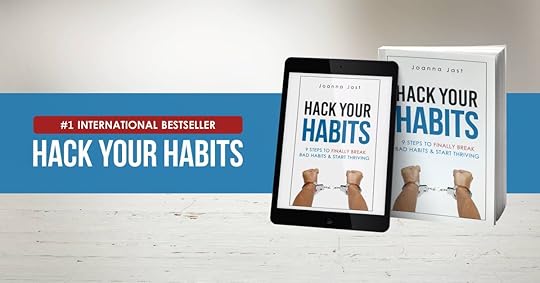
For book recommendations I’ve found useful, please try:
Hack Your Habits
Laser Sharp Focus
9 Brain Exercises
3 More Common Causes Behind Your Difficulty Focusing
1. Not having a vision statement for your life.
Do you have a plan for where you’re going to live and what you want to be doing when you’re 95? How about when you’re 150?
I’m not kidding. As Dan Sullivan has pointed out, when people are asked when they think they’ll die, they usually list a number between the range that matches the widely published life expectancy statistics.
Maybe that’s why so many people are stressed.
How about this alternative? Get out a journal and write down your vision for each coming decade of your life. For example:
When I’m 80, I plan to take every opportunity to visit the gym. I will be thoroughly knowledgeable of recent medical advancements and taking advantage of every possible means of delaying the onset of disease from natural aging.
You can relieve a lot of worrisome thoughts that break your focus by repeating this exercise with your family goals, financial goals and travel desires. This is your life, so dare to dream big!
2. Not having a plan.
Having a vision is one thing, but then you need to plan.
Rest assured, no matter how much planning you perform, life will throw curveballs.
However, the act of planning accomplishes (at least) two things:
You have documented plans. Without plans, you put stress on your memory and stumble through life blindly.
You develop the skills of planning. When things change, you can rapidly chart out a new plan.
One useful planning skill you can learn is mind mapping. I suggest Mind Map Mastery as a great resource for learning how to do it well.

In sum, when you have plans and the skill of making plans, you’ll reduce a ton of focus-destroying stress that come in the form of unwanted thoughts.
3. Short Form Content Addiction
Let me rant a little here.
Those 5 minute videos you’re watching?
They’re killing your attention span. Especially when you’re watching them on your so-called “smartphone.” (You can learn how to combat smartphone addiction here.)
If you really want to master the skill of mental focusing, you need to go on a short content diet.
Next time you’re searching for information on a topic you want to learn, choose the longest and most in-depth content you can find.
Get out a pen and paper. (No devices with their focus-stealing tabs and apps and widgets.)
Sit with the content for the long haul. Engage with it thoroughly. And remember diffuse thinking – if you get bored, doodle on the paper instead of taking your attention away. That’s just one of 5 unconventional note taking tips I have for you.
https://www.youtube.com/watch?v=U64aw...
The more you engage with long form content, the more you’ll start to heal your flighty attention span.
Rest assured: I’m as tempted as the next guy to hop around multiple pieces of short content.
But it’s not a realistic strategy if you really want to learn. If anything, you want to not only watch long videos and read long books, but you also want a rereading strategy that takes you through the content twice.
3 More Strategies for Destroying Your Lack of Concentration
1. Form study and/or discussion groups based around a single topic.
When I was in university, I always belonged to study groups. Not only was I president of the English Undergraduate Student Association, a position that allowed me to create groups and invite interesting speakers. I also sought out and belonged to poetry discussion groups, philosophy groups and film studies gatherings.
Look, there are problems with groups, such as timing them, having someone capable of leadership and the fact that not everyone will complete the agreed upon readings, etc. But that’s no reason not to go and flex your skills at being the leader and the reader. These are precisely the activities that will stretch your concentration skills.
2. Learn a language.
A lot of people start learning a language and then give up. They don’t have the attention span for it, or they come up with a whole list of excuses about it being “hard.”
The fact is that without challenge, we cannot grow. And taking up a long term learning project like picking up a foreign language has been scientifically proven to increase your “cognitive reserve.” That basically means that your memory improves, as does your ability to find the words you want to use quickly.
3. Volunteer.
So many people are aimless these days. They don’t have any vision or purpose for their own lives, and they certainly don’t lend their time and energy to causes larger than themselves. 
I recognized this as a problem in my own life, which is why I started teaching freely on the Internet and became part of the Pollination Project for a few years. I found that by being part of a mission with positive consequences for other people around the world, nearly all of whom I would never meet, a lot of my thoughts became very focused.
I think you’ll find this is true for you too, and there are a lot of compelling studies showing that giving, not receiving is the true path to lasting happiness.
However, you need to watch out for what is called volunteer’s folly. For example, if you’re an amateur at building shelter, your volunteer hours won’t be nearly as powerful as donating money to hire expert builders. Not only are you creating unprofessional housing that will need many costly repairs or outright replacement. You’re also failing to hire a local company that could use the revenue. (Rolf Dobelli points this problem out in The Art of Thinking Clearly and it is very easy to avoid.)
Conclusion: Concentrate On Creating Memories Worth Having
One last tip based on research by Tim Dalgleish that I discovered years after feeling the effects of it myself.
Remember when I told you about my depression and bad habits while completing my PhD?
Well, on top of becoming a student of focus techniques like meditation, I also started using an ancient device called a “Memory Palace.” (Sometimes called the Roman Room Method or the Method of Loci.)
This ancient device lets you use buildings like your home and workplace to remember information quickly.
In “Method-of-Loci as a Mnemonic Device to Facilitate Access to Self-Affirming Personal Memories for Individuals With Depression,” Dalgleish’s research has shown that memorizing positive information also boosts your mood – even if you have depression or other ailments.
Here’s what to do in order to experience the results of his research:
Create a Memory Palace. My free memory improvement kit walks you through everything:
Populate your Memory Palace with 5-10 happy memories. For example, in one of my Memory Palaces, I placed a scene from the party after my dissertation defense in one corner of a room. In another corner, I placed the memory of my first book arriving after it was printed, and so on.
Use the Memory Palace to revisit your happy memories – especially during moments when you can’t focus.
I use this technique to this day. It is powerful.
You can combine it with other elements from your meditation habit stack, such as wandering your Memory Palace of happy memories mentally while you walk your neighborhood for exercise.
So what do you say?
Are you ready to become a serious student of improving your concentration?
July 20, 2020
What Causes Memory Disorders And How To Overcome Them?
 Misplaced your car keys?
Misplaced your car keys?
Forgot a new acquaintance’s name?
Confused about what day of the week it is?
These are all common occurrences.
But could these memory lapses be symptoms of memory disorders?
In this article, I’ll walk you through 5 common memory disorders and their symptoms, diagnosis, and treatment.
I’ll also introduce you to a powerful technique to supercharge your brain power and help prevent simple memory loss.
Here’s what I’ll cover:
What Are Memory Disorders?
Five Memory Disorders: Symptoms, Diagnosis, and Treatment
Why Must Memory Disorders Be Diagnosed Early?
How To Strengthen Your Memory?
What Are Memory Disorders?
Forgetting your house keys is basic forgetfulness.

But when memory impairment starts to interfere with your daily tasks, social activities, and work, you might have a memory disorder.
Memory disorders are problems associated with communication, decision making, recollection, reasoning, and cognitive skills. A memory problem could also occur due to neurological damage to your brain structure.
Besides causing immense psychological stress, they also affect your ability to create, store, and recall memories.
Memory impairment could occur due to:
A side effect of medication
Brain impairment
Trauma to the head
Substance abuse
Vitamin deficiencies
An untreated metabolic disease or infection
Cardiovascular disease
Heredity
Aging
It’s tough to pinpoint the actual reason for memory disorders. And this is what makes their diagnosis challenging.
Curious to know if your memory problem is a memory disorder?
Let’s find out.
Do Age-Related Memory Problems Always Mean Memory Disorders?
Cognitive decline usually develops with age. Older adults with no memory disorder problems may pause to remember directions, but they do not get lost in familiar places.
Forgetting where you kept your reading glasses is just a sign of normal aging. In this normal aging process, your judgment remains intact, and the memory problem doesn’t affect your routines.

However, if an older adult starts forgetting what reading glasses are and how they are used, it could point to a memory disorder.
Research indicates that the amount of hippocampal neurofibrillary tangles or protein deposits in the cortex help differentiate between normal aging and a memory disorder.
Are all memory disorders alike?
Short answer: No.
Different memory disorders have different progress rates and involve different brain structures.
Some memory disorders like Alzheimer’s are progressive, and it may take years before the symptoms appear. Others like frontotemporal dementia are also progressive and cause reduced brain function in the frontal and temporal lobes.
Damage to brain function caused by traumatic brain injury like a car crash has an immediate effect.
Some of these cognitive disorders can be treated, while others like anterograde amnesia don’t have a cure yet. However, there are many scientific solutions to assist patients to go about their daily lives.
Early clinical assessment can help determine the future course of action. Behavioral neurologists can assess the patient to understand the extent of cognitive impairment.
Patients can take remedial steps by attending a memory disorders program to manage symptoms and improve their quality of life.
5 Memory Disorders: Symptoms, Diagnosis, and Treatment
Let’s take a look at 5 common memory disorders.
1. Alzheimer’s Disease
Alzheimer’s Disease is a neurodegenerative disease – a type of dementia – which causes problems with memory, thinking, and behavior. It also happens to be the sixth leading cause of death in the world!

Alzheimer’s Disease is named after Dr. Alois Alzheimer, who reported “a peculiar severe disease progress of the cerebral cortex” in 1906 in Tubingen to the 37th Meeting of South-West German Psychiatrists.
Symptoms of Alzheimer’s Disease
Alzheimer’s disease is most common in people above the age of 65. This is called late-onset Alzheimer’s disease. The other two types are early-onset Alzheimer’s disease, which typically occurs in people of the 40-50 age group, and Familial Alzheimer’s disease which is linked to genes.
Alzheimer’s symptoms develop gradually, worsen over time, and eventually affect all everyday tasks.
The typical symptoms of people with Alzheimer’s disease are:
Memory loss that worsens gradually
Changes in mood and behavior
Disorientation
Trouble communicating with others
Confusion about time, place and events
Depression
Difficulty walking, swallowing food, and speaking
How Does Alzheimer’s Disease Affect the Brain?
Alzheimer’s disease AD damages nerves, degenerates brain tissue, and leads to the accumulation of an abnormal protein called beta-amyloid and the development of neurofibrillary tangles.
It affects the hippocampus first, which is why memory loss is often the first symptom in a person with Alzheimer’s disease. Microglia cells then create inflammation to start the immune response, which further damages the brain. Eventually, it affects the entire brain.
Diagnosis of Alzheimer’s Disease and Treatment
There is no single Alzheimer’s disease and memory test or any particular cognitive test to detect Alzheimer’s disease.
Because of this, an Alzheimer’s disease center will use a combination of factors and tests such as:
Detailed medical history
Assessment of Alzheimer’s disease memory, problem-solving, and other mental abilities
Standard blood and urine tests
Brain imaging, such as CT, MRI, or PET scans
There is no cure for Alzheimer’s disease, yet.
Take any Alzheimer’s disease research center, and you’ll find several ongoing clinical trials that attempt to slow down the progress of the disease.
People in the early stages can enhance their cognitive function and manage the signs of Alzheimer’s disease with medication. They can also use behavioral treatments like speech therapy, and technological solutions like smart wearable devices along with medication.
Patients can also seek help from health organizations like the Alzheimer’s Association or any Alzheimer’s disease center for care and support.
2. Dementia
Dementia is a neurological disorder that makes it harder for individuals to remember, communicate, and reason with others. It is caused by constant damage to the brain cells.

There are different types of dementia, including Alzheimer’s and Lewy body dementias. (The Lewy body disease is associated with abnormal deposits of the alpha-synuclein protein in the brain.)
Other diseases like Huntington’s disease and multiple sclerosis can also lead to dementia. Wernicke-Korsakoff Syndrome, which is caused by thiamine deficiency, can also cause dementia.
Symptoms of Dementia:
There are a few common symptoms:
Memory loss that interferes with familiar tasks
Trouble with language — understanding and expression (like in Parkinson’s disease)
Problems with judgment
Personality changes
How Does Dementia Change the Brain?
Most changes that occur in the brain due to dementia are permanent and get worse over time. It interferes with the ability of brain nerve cells to communicate with each other. Different types of dementia affect different brain regions first.
Diagnosis of Dementia
Dementia can be diagnosed using:
Neuropsychological tests where a neuropsychologist assesses mental functioning
Analysis of bodily fluids such as blood, urine, and saliva
Brain scans to identify changes in the brain structure
Psychiatric evaluation
Treatment for Dementia
A disease like dementia is incurable. Medicines and therapy can only make dementia patients feel better temporarily.
The good news is, people with dementia can live comfortably by routinely exercising and engaging in some form of activity.
Assistive technology can help dementia patients stay independent and safe as long as possible. For example, Google calendar to help them remember things to do, and video calling apps to help them connect with their loved ones.
Routine health checkups are also a vital part of a dementia patient’s life.
3. Mild Cognitive Impairment
Mild cognitive impairment (MCI) is a transitional state between dementia and normal memory and thinking (cognitive abilities). It is a slight yet noticeable cognitive decline.

Individuals with mild cognitive impairment have more difficulty with memory, language, and thinking than others their age. They also have a high risk factor of developing dementia or Alzheimer’s.
However, some mild cognitive impairment patients remain at a stable state or regain their normal cognitive abilities over time.
Symptoms of Mild Cognitive Impairment
There are two types of mild cognitive impairment — Amnestic MCI and NonAmnestic MCI. Amnestic MCI deals primarily with memory loss, and NonAmnestic MIC deals mostly with a decline in thinking skills.
Here are some symptoms of Mild Cognitive Impairment:
Impulsive behavior
Getting overwhelmed while doing simple tasks
Forgetting appointments and other social engagements
Feeling lost and confused
How Does Mild Cognitive Impairment Impact the Brain?
The changes in the brain are similar to Alzheimer’s dementia but less intense.
Mild Cognitive Impairment results in:
Shrinkage of the hippocampus
Enlargement of ventricles
Reduced use of glucose
Abnormal clumps and tangles of nerve cells
Reduced blood flow through brain blood vessels
Diagnosis of Mild Cognitive Impairment
For the diagnosis of mild cognitive impairment, the doctor looks into:
A complete medical history
Inputs from a family member or a close friend about daily activities
Psychiatric evaluation to trace signs of depression
Brain imaging
Behavioral neurology examination
These evaluations have to be done every six months as patients with mild cognitive impairment are at increased risk of dementia and Alzheimer’s disease.
Treatment for Mild Cognitive Impairment
The treatment mostly focuses on managing or easing symptoms. Medications are used only in cases of significant memory changes or for someone who is also exhibiting symptoms of Parkinson’s.
Those experiencing depression often benefit from psychotherapy. Treating other underlying conditions such as cholesterol and hypothyroidism is also a good idea.
Lifestyle changes and maintaining cognitive health can allow patients with Mild Cognitive Impairment to stabilize their condition without making it worse.
4. Autoimmune Encephalitis
Autoimmune Encephalitis is a rare disease that occurs when the body’s immune system attacks healthy brain cells and causes inflammation.

This disease is caused by viruses, including rabies, herpes simplex virus, toxoplasmosis, and the West Nile virus.
Symptoms of Autoimmune Encephalitis
Initially, some patients may exhibit neurological or psychiatric symptoms, and that makes this disease tricky to diagnose.
The symptoms could be:
Tremors (like in people with Parkinson’s disease dementia)
Seizures
Involuntary movements
Loss of inhibition
Paranoia
Severe insomnia
Depression
Loss of balance
How Does Autoimmune Encephalitis Affect the Brain?
The body’s immune system attacks healthy brain cells, leading to inflammation in the brain.
Diagnosis of Autoimmune Encephalitis
This disease is challenging to diagnose, as the symptoms appear at different times with different intensity levels.
Patients need to meet these criteria:
Rapid progression of working memory deficits, altered memory status, or psychiatric symptoms.
And one of these criteria should be met:
New focal CNS findings
Unexplained seizures
Increased white blood cell count
MRI suggests encephalitis
Treatment of Autoimmune Encephalitis
Early detection and quick treatment are necessary for the treatment of this disorder. Patients should be hospitalized immediately. The treatment is focused on preventing complications, reducing swelling, and controlling seizures and fevers.
5. Vascular Cognitive Impairment
Vascular Cognitive Impairment is a common form of dementia in older adults. It is caused by decreased blood flow to the brain, which eventually damages the brain tissue.

There are many types of vascular dementia, including:
Mixed dementia, where symptoms of both vascular dementia and Alzheimer’s disease exist.
Multi-infarct dementia where the blood flow affects a specific part of the brain.
Stroke-related and post-stroke dementia may also be a cause of vascular cognitive impairment.
Symptoms of Vascular Cognitive Impairment
Symptoms of Vascular Cognitive Impairment could develop gradually or appear suddenly after a stroke.
They are:
Inability to carry out instructions
Concentration and communication problems
Memory loss
Movement troubles (like people with Parkinson’s disease)
Tremors
Urinary problems
Depression
How Does Vascular Cognitive Impairment Affect the Brain?
The effect of vascular cognitive impairment depends on the location and size of the affected area in the brain. It occurs due to blood clots, ruptured blood vessels due to atherosclerosis, high blood pressure, and infection.
Diagnosis of Vascular Cognitive Impairment
Doctors conduct the following tests in addition to taking a detailed medical history and physical examination:
Brain scans such as CT, PET, and MRI
Electroencephalogram (EEG) of the brain
Neuropsychological and neuropsychiatric tests
Treatment of Vascular Cognitive Impairment
Vascular Cognitive Impairment cannot be cured. Any treatment will only manage the associated conditions.
Doctors could advise:
Medicines to control blood pressure, diabetes, and blood clotting
Procedures like angioplasty to improve blood flow to the brain
Lifestyle changes, including exercises for cognitive stimulation and cognitive rehabilitation.
With so many complications associated with memory disorders, it is imperative to diagnose them early.
Here are a few more reasons why it’s essential to do so.
Why Must Memory Disorders Be Diagnosed Early?
Being diagnosed with a memory disorder can be disorienting for the patient and their caregivers.

Early diagnosis can:
Explain your symptoms and reduce your anxiety
Give you access to treatments to slow down the disease
You could find a place in a clinical trial for a miracle drug
Give you time to prepare for the future, both emotionally and financially
Help you to preserve your cognitive skills and abilities
There is a cultural aspect to it as well.
In many societies, there is a stigma against those who suffer from mental illness. There have been several cases of patients being denied jobs, denied places to stay, and having false criminal charges levied against them.
Keeping all these factors in mind, prevention is definitely better than a cure.
You may be able to delay or prevent the onset of memory loss by merely exercising your brain regularly!
A regular brain workout will be extremely helpful even if you’re only struggling with minor memory loss.
How do you do that?
Build Memory Palaces And Give Your Brain a Workout
Using a Memory Palace is the ultimate brain exercise to boost your cognitive abilities.
Creating a Memory Palace stimulates your spatial memory, visual memory, recovered memory, and autobiographical memory.

So, if you forget what day of the week it is, try this out:
When you wake up in the morning, imagine you’re looking at a gift box with seven boxes within.
In each box, place an image. For example, in the first box (Monday) place a man. In the Tuesday box, place a truck. On Wednesday, a walrus, and so on.
These mnemonics will help you remember the day when you wake up.
Remember to mentally cross out the day’s symbol and keep the day’s box aside before you hit the bed.
This way, you will think of what happened yesterday when you wake up and instantly remember the day.
You can remember pretty much anything using a Memory Palace — names, faces, grocery items, a new language, academic material… the list is nearly endless.
Attaching physical locations to memories helps you access them with ease.
Building Memory Palaces is a technique you can use for life. Once you build one and master using it, you can create plenty more with ease.
And, if you can do that – like Sherlock Holmes – you can do great things with your memory.
Ready to supercharge your memory and keep cognitive disorders at bay? Pick up your copy of my free memory improvement kit, and get started today!
July 14, 2020
How to Memorize the Periodic Table: A Proven Process
 If you want to memorize the periodic table, chances are you’ve heard the following advice:
If you want to memorize the periodic table, chances are you’ve heard the following advice:
Use songs
Use flash cards
Use acronyms or acrostics
Use associations
Use a Memory Palace
Some trainings even suggest that you combine all of the above in order to speed up the process.
If such vague suggestions make you want to pull your hair out, let’s talk about the truth so you have a real shot at getting what you want:
The only way anyone can memorize the periodic table quickly is to already be good with memory techniques, ideally the Memory Palace technique. In fact, you’ll probably want several Memory Palaces in the manner I’ll show you in this guide.
But don’t put the cart ahead of the horse.
And don’t fall for the clickbait nonsense about memorizing the massive amount of information on the periodic table “fast.” Rest assured, there’s no question that it can be done. You just need to have the real secrets of how to do it already working for you.
So if you’re ready for the real deal and really want to know how to learn the periodic table, let’s get started.
https://www.youtube.com/watch?v=sahjk...
Learning The Periodic Table The Right Way
As I’ve just revealed, this process is only going to be fast if you already know your way around memory strategies like the Memory Palace.
But even knowing how to memorize the elements of the periodic table will not necessarily mean that you’ll actually do it. And it also doesn’t mean that you’ll understand the information encoded by the table.
So the first step you need to cover has nothing to do with memory techniques.
You have to know your reason why. Seriously: Why do you want to memorize this information?
If you don’t already keep a Memory Journal, get one. Then, on a fresh page, write out at least 5 reasons why you want to memorize this particular information.
Is it to show off?
To pass an exam?
To become a great chemist?
If you cannot find five distinct reasons why, then it’s time to face the facts: You’re probably going to give up because the sheer mental strength needed without a reason why is just too much for most mere mortals to pull through such a goal.
What Do You Need To Memorize From The Periodic Table?
Next, think about exactly what you need to know. Do you need to know the names? The abbreviations? The atomic numbers? Do you have to recall each element in order? Do you have to be able to visualize the table in your mind?
These possibilities are important to know, because this information will shift how thoroughly you approach the task.
Next, I want you to make sure you perform a bit of “brute force learning.” This means knowing:
Who created the Periodic Table
When it was created
Why it was created
What changes have been made to it over time
What problems it solves
How it solves those problems
As you go through its Wikipedia and associated information, you’ll be laying the groundwork for some of the next-level memory tools that will help you truly learn it, not just memorize its information. You’ll see just how important this will be for your success soon.
How to Memorize the Periodic Table: A Proven Process
Now that we’ve abandoned the fantasy that this task can be done quickly without pro memory skills first, and covered having a good reason why, here’s the next step most memory experts and memory athletes would use:
Have a number of Memory Palaces ready.
I think of these clusters as “Memory Palace Networks.”
To create them quickly, go back to that Memory Journal.
How long should it take to create each Memory Palace?
The answer depends on your current level of skill. But for most people who complete my training, each one should take no more than 2-5 minutes. I suggest you draw them and there are at least three reasons why:
https://www.youtube.com/watch?v=Ntbec...
Now, there are many different ways you can configure your Memory Palaces. I’m going to take you through an intermediate-level suggestion that will hopefully get you excited so that improving your skills with memory techniques is a no brainer.
But always remember this:
How you choose to proceed will depend on your exact goal, something only you can identify.
Let’s continue with the steps you need to consider.
Obviously, you’ll want a diagram of the Periodic Table. You can download this one for free at Pixabay.

I suggest you print it out and paste a copy in your Memory Journal. Put a second one on your office wall, or somewhere you’ll see it every day. That’s not to help you remember any of the information. It’s to help you remember your commitment to the goal of memorizing everything on it.
Spend some time just looking at the information. Observe it closely.
Here’s what I observe as a mnemonist who works on memorizing large bodies of information:
The periodic table has two blocks. Whereas one is irregularly shaped and large, the other is small and uniform.
On the top block, you have columns that have either seven or four blocks each. The final four horizontal columns contain eighteen units of information. (In fact, each block contains three or four distinct pieces of information, but we’ll get to that later.)
Let’s keep focused on the top block and think about some of the ways we can use the Memory Palace technique to memorize the information.
My first instinct is to create seven Memory Palaces to cover the large block on the top.
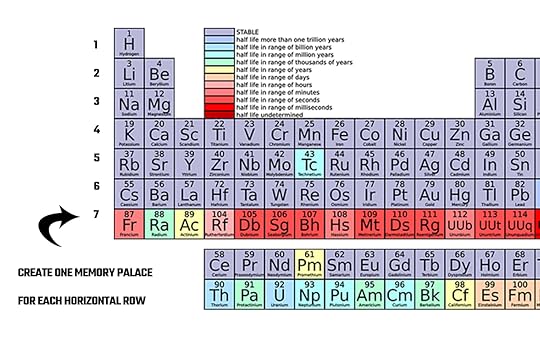
For example, Hydrogen and Helium would be in Memory Palace one. Using the Method of Loci, this Memory Palace would have just two stations.
The second Memory Palace would then have eight stations to cover Lithium to Neon.
Once complete, I would take a break before adding two more Memory Palaces of fourteen stations each for the second, regular-shaped block.
Let’s have a look at how this would play out from a purely spatial perspective using the second horizontal column.
This column contains eight elements. To rapidly memorize them, I would then want eight Magnetic Stations in a well-formed Memory Palace.

In my studio bedroom in Berlin. One of my favorite Memory Palace sources.
These Magnetic Stations follow all the Magnetic Memory Method principles and are:
Bookcase (barely visible in the photo, but it’s there)
Bed
Music stand
Poster
Chair
Wall
Guitar
Wall
Don’t worry if this isn’t clear yet. I’ve got 5 more Memory Palace examples you can learn from.
Now, I know what you’re thinking:
I wanted an easy way to memorize the periodic table! And now you’re placing the information from right to left, instead of left to right!
Trust me, this is not only incredibly easy once you have the skills. It’s also a lot of fun. And the reason that I am laying out the information in what appears to be the opposite direction will take an entire course to explain. Why not pull up a seat in my course and learn all about it now?

Once you’re in, let the fun begin based on the real knowledge of how the ancients memorized mountains of facts like the Periodic Table.
How to Remember Each Element
Let’s recap:
You want to have enough Memory Palaces to memorize all of the elements. For that, you need to create a Memory Palace Network. You could potentially memorize every single element in just one, but I think that’s putting too much pressure on most minds. I certainly would not approach the task that way.
You also need to decide how you want the information to fall in the Memory Palaces. I’ve chosen a horizontal method. However, you could just as easily choose a vertical method. This approach would require at least eighteen Memory Palaces, but you could do it with less if you’re skilled and work out your strategy.
Now we need to figure out how we’re going to place the information in these Memory Palaces. We do this through a process called elaborative encoding. It’s a scientific term for taking information we already know and associating it with information we don’t know. Or, in the case of a word like Lithium, which pretty much everyone knows, we just want to know where it falls on the table and additional information related to it.
If you’re familiar with one of the ways to use the pegword method, you might draw upon those skills.
Here’s where your “why” and exactly what you need to memorize is going to be important.
Let’s take Lithium, for example:

On this version of its Periodic Table listing you have:
Atomic number (3)
Element symbol (Li)
Full name (Lithium)
Atomic mass (6.938)
Let’s say we want to account for all of this information. The best approach will probably be to memorize from the top-down, starting with the atomic number. In this case, we’ll need to use the Memory Palace accordingly. Like this:
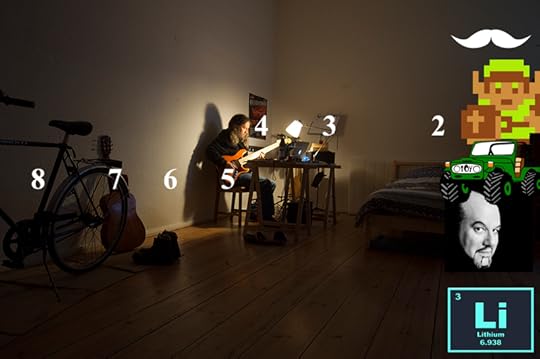
This mnemonic example shows the placement of periodic table information in a Memory Palace.
Let me explain these images:
Atomic number = moustache. Using a number-shape system, 3 looks a lot like a moustache on its side. As an alternative, you could use macaroni or the McDonald’s logo.
Element symbol = Link from The Legend of Zelda. I actually think about his LinkedIn profile (i.e. Li.)
Full name = It’s not reflected in the mnemonic example above, but I imagine that Link is listening to the Nirvana song “Lithium.”
Atomic Mass. In this case, I am drawing upon a 00-99 PAO (Person Action Object) system. It’s built on the Major Method.
For reasons you’ll discover by learning any of the main techniques for memorizing numbers, Jeep is my personal image for 69 and Max Maven is my image for 38. There are many different images you can choose from, and mine have evolved over time.
Your next memory trick is to get these images interacting in a multi-sensory way. Here’s How to Build A Memory Palace which includes details on making this happen in a memorable way.
https://www.youtube.com/watch?v=l5-Yr...
The basic idea is to create a kind of chain reaction with special properties you can train yourself to automatically tap into with these sensory memory exercises.
In this case, the moustache which represents three crashes down on Link who uses his wooden sword to pop a tire on the Jeep, causing a bolt to fly at Max Maven, who stops it using magical powers. The bolt represents the decimal in 6.938. As this entire image unfolds, I hear the Nirvana song Lithium as if I were Link listening to it.
How To Make Sure Each Element Gets Into Long Term Memory
I suggest you start small and work one column at a time. If you choose the horizontal columns method, you’ll have them all memorized in numerical order by their Atomic Number.
In each Memory Palace, I suggest that you use a process called Active Recall. It means that you deliberately ask your memory to bring back the information you placed in the Memory Palace.
In my case, I would think about the bookcase. Then, I would relax and ask myself… “What was happening there?”
Because I have practiced these techniques for many years, I’ll probably think about the moustache, guided by the fact I decided upon how much of the information I wanted to know from the beginning. (Remember, you have to know your goal intimately first.)
If you only wanted to remember the world “lithium,” then obviously you would want to call back the imagery you created and placed in your Memory Palace just for that target information.
Next, I’ll assume that you’ve memorized all eight of the Elements that appear in this horizontal column.
You’ll want to call them to mind first, then write them out by hand in your Memory Journal. (Make sure you don’t cheat, however. Genuinely test yourself first and check the answers only later.)
Later, when you’re certain that your Magnetic Imagery is working, recall each Element you memorized in the following patterns:
Forward (Magnetic Stations 1-8)
Backward (Magnetic Stations 8-1)
From the middle to the beginning (Magnetic Stations 4-1)
From the middle to the end (Magnetic Stations 5-8)
Station skipping (Magnetic Stations 1,3,5,7,8,6,4,2)
Why follow these patterns?
Because you will be harnessing the best of:
The Primacy Effect
The Recency Effect
The Serial Positioning Effect
Sure, you can get Anki or some other spaced-repetition software to present the information to you based on similar patterns.
The Problem With Software For Learning The Elements
But the problem is that these softwares don’t get you bringing together the forces of creative repetition and active learning. Your brain needs a bit of challenge to learn.
And when you use the techniques I shared with you today, you’ll get real results. And then you can apply your memory to even more challenging goals.
Everything begins when you’re sure about your why and you’re clear about what exactly needs to be memorized. Once you’ve got that covered, you truly can learn so fast, it’ll make you head spin – in a good way, of course.
July 8, 2020
5 Proven Mnemonic Strategies You Can Use to Remember Anything
 You’d like a bunch of mnemonic strategies that help you learn faster, right?
You’d like a bunch of mnemonic strategies that help you learn faster, right?
Whereas nearly every article on the Internet is going to give you a bunch of weak techniques like “keywords,” here’s the thing you need to understand:
Using the keyword method as a mnemonic device is not a strategy. It’s a tool.
A strategy, on the other hand, is how you design your life so that you can use memory techniques.
So if you want proper mnemonic training, buckle up because we’re going to give you some mnemonic device examples, and in a way that doesn’t muddy the waters.
What Is A Mnemonic Device And How To Use One Strategically?
https://www.youtube.com/watch?v=doUSE...
A mnemonic device is anything you use to help you remember something. That includes everything from rote learning with flashcards to using a Memory Palace.
If you want to use flash cards strategically, then you need to add a mnemonic element. For example, instead of showing yourself the same card repeatedly and hoping the information will stick, to use flash cards strategically, you will combine a mnemonic technique like elaborative encoding with active recall based on a spaced repetition pattern.
For example, I’ve used elaborative encoding to make the German word Bereich (area) more memorable:

Mnemonic Example for the German Word Bereich
This approach is strategic because:
1) I used my hands, colors and a non-digital tool I could easily revisit both physically and mentally.
2) I did not cheat by including the target information anywhere in the mnemonic device. This forces me to at least try to use active recall.
3) This drawing is linked to a Memory Palace that enables mental spaced repetition based on a few principles (Primacy Effect, Recency Effect and Serial Positioning Effect).
Although I am not a great artist (and you don’t have to be), this approach is so much faster and effective than spaced repetition software. I was inspired to start drawing my mnemonic examples in this way by language learning expert Gabriel Wyner. His book Fluent Forever is incredible.
To sum up before we dig deeper, mnemonic devices are not strategies.
The device is the association of Bender from Futurama with the German word Bereich. It means “area” and in my imagination, Bender is in Berlin’s Tegel airport.

A memory strategy can involve importing one location into a Memory Palace based on another space.
The next next device I’m using is association through imagery.
Actually, it’s not “imagery” in the way we normally mean it. I actually don’t see a picture of any of this in my mind.
Instead, I’m operating more on the level of observation and sound. You see, “Bender” starts with ‘be” and so does “Bereich.” And if you look at my drawing again, you’ll see there’s a drummer in the image.
That’s Steve Reich, a very important drummer in the history of percussion. Be + Reich = Bereich.
Easy, right! Yes, but most people fiddle around with the “keyword” method, an agonizingly inadequate approach when you’ve got real memory tasks to conquer.
Another strategy I deploy is to have multiple words in the Memory Palace, but to focus only on words.
Now, when you’re learning a language, you definitely want to memorize phrases, but you have to start somewhere.
So my strategy is to start by memorizing 5-10 words and then add phrases. This works because it’s always important to not put the cart before the horse.
Finally, the main device I draw upon in strategically revisiting this location in the Memory Palace. There are quite a number of ways you can make this work, but it’s important to:
1) Revisit the memorized words forward
2) Backwards
3) Out of order
There are more patterns you can deploy and I cover them in Memory Palace Mastery. Why not grab your seat now? I’ll show you exactly how to build a Memory Palace in the most effective way.
And focusing on effectiveness is important because it’s the path to ease and efficiency. To help speed up the process, you do want to keep a record of what you’ve memorized, and you do that in a Memory Journal. Then, when testing your memory, you need to use active recall in order to generate the memories.
That means using a fresh piece of paper or a testing Memory Journal where you have no access whatsoever to the target material. (In this way, each of these two Memory Journals are also kinds of mnemonic devices.)
For example, when I have memorized long Sanskrit passages, I do it purely from the books I’m reading that feature texts like you can hear me reciting here:
https://www.youtube.com/watch?v=kvtYj...
Later, I write out what I’ve memorized from each session. I do my best and only after I’m finished do I check the record. That’s also how I tested my memory of the TEDx talk itself: I wrote it, memorized it and then wrote it out by hand without the original record anywhere in sight.
The Most Highly Effective Mnemonic Strategies & Techniques
This might surprise you, but it actually doesn’t matter which is the most effective for me or some other memory expert.
The best mnemonic strategies are the ones you’re actually going to use.
And to figure that out, you need to try a few on for size. To do that, here’s what I suggest:
Do your research. The market is filled with all kinds of memory trainers. I suggest you find the one who has accomplished what you want to accomplish.
For example, I’ve learned languages, given speeches and completed a PhD. If you want to do those things, chances are, I’m your guy.
But, I’ve only done moderately well at memory competitions.
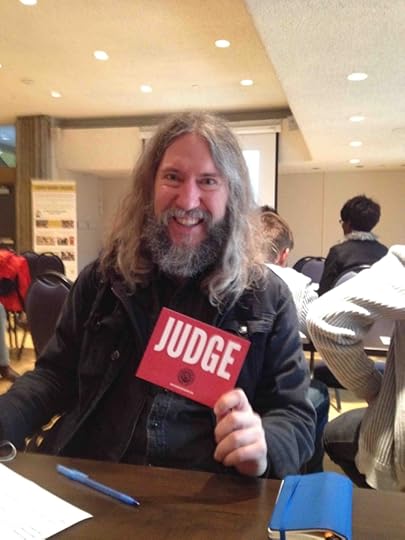
Anthony Metivier judging at a memory competition.
Personally, I like memorizing cards, but the idea of memorizing endless digits, words and abstract shapes I’m going to forget immediately after the competition is over… I just have no interest in that.
However, a lot of people love memory competitions and I’ve interviewed a lot of the best memory athletes on the Magnetic Memory Method Podcast.
Seek them out. Many have books and courses of their own. Just be realistic about who has done what. There’s a big difference between using these techniques to forget what you’ve memorized after the games are over and the ability to hold on to the information for the long term.
Stick with the program. Too many people get started and then fall off the horse. If that’s you, forgive yourself and then go through my mental strength free training. It will help you keep on track.
How long do you need to study the mnemonic strategies of the memory master you’ve chosen?
I’d suggest at least 90 days. I haven’t plucked that number out of thin air. Many studies show it is the bare minimum for lasting habit formation. Dr. Richard Wiseman has gathered a bunch of them in his book 59 Seconds, and you’ll see similar data repeated in any good book on the science of success.
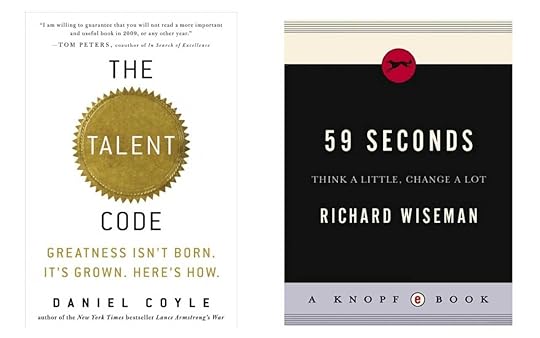
Have a vision. One reason people can’t practice the mnemonic strategy of their choice is because it isn’t embedded in a clear picture of what a realistic accomplishment looks like.
Again, I have zero interest in competition but that doesn’t mean I don’t “compete” against time. I was once invited to teach memory techniques in Guilin, China.
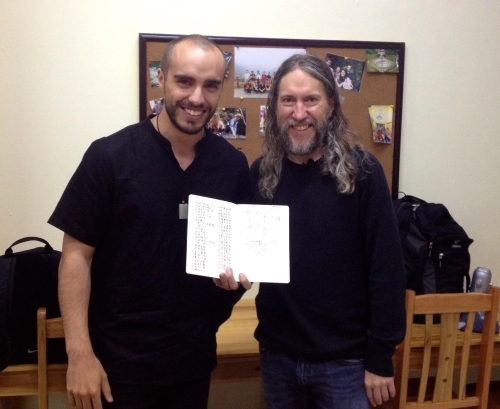
I had less than 3 months to study the language, but I made a very specific vision: That I would have a 300-500 word vocabulary and basic abilities in the language.
Because I was clear (and realistic) about the vision, I wound up at the school and my teachers were blown away! I even wound up meeting a beautiful woman who later became my wife. And then I rapidly memorized a song in Mandarin to sing at our wedding.
Practice frequently.
Listen, I’m not the greatest singer in the world, and I don’t want to torture your ears. But there’s a reason why I recorded this video while washing the dishes. And that reason is to demonstrate how I take every possible opportunity to practice:
https://www.youtube.com/watch?v=dCyPV...
Let go of the outcome.
This mnemonic strategy is counterintuitive, but it is the ultimate secret of success.
A lot of people try to “force” the techniques to work. Sure, that can create success sometimes, but we actually need to create flow around them.
So when I practice, I mentally give myself permission to make mistakes. I don’t try to get it right. I just visit the Memory Palace and allow the imagery to come back.
If I haven’t been specific enough with the associations or the Memory Palace creation was sloppy, I’ll definitely feel it.
But I don’t allow myself to get frustrated. I just note any mistakes or struggles and analyze what’s going on so I can improve it rationally instead of from a place of negative emotion or need.
Once you put these strategies together in one tight package (with frequent practice), you’ll find that the memory mnemonics you use make your mental life a much finer journey to experience.
Savor it and let me know in the comments if there are any strategies I missed.
July 1, 2020
How to Memorize a Monologue: Your Quick and Easy Guide
 Is learning how to memorize a monologue really fast and easy?
Is learning how to memorize a monologue really fast and easy?
You bet! You just need a trained memory.
To be fair, there’s a bit more to it than that when it comes to verbatim delivery on a stage. I’m talking about the roles of research, context, practice and analysis.
And let’s be real for a moment. In order for anything to be fast and easy, there’s going to be a period of learning, training and analysis, followed by reflection on your practice.
This combination of factors is how the best actors and speakers rise to the top. It’s how you can receive a monologue and within twenty four hours recite it accurately and with verve. And it’s how you get invited back to speak or act some more.
So if you want to enjoy a career as someone who speaks from memory, using some examples, in this post I’m going to cover:
Creating mental context to help your memory
The Memory Palace technique
Practice and analysis
Performance and analysis
Troubleshooting
5 Strategies For Memorizing A Monologue
Context
Let’s assume that we want to memorize two monologues from Shakespeare’s King Lear to show our range. We’ll pick one from Edmund and one from King Lear himself.
I suggest you head over to IMDB and YouTube to find some examples. One of my favorite filmed stage performances of King Lear is the 1974 Great Performances version starring James Earl Jones and Raul Julia.
Another great version is the 1983 Granada version starring Laurence Olivier and John Hurt. The more versions you can find, even just in the form of clips on YouTube, the more you can seep your mind in timing, intonation and spatial awareness that are useful for memorizing the lines.
Also, it’s a good practice to look into actors who have taken on such roles and listen to them talk about their craft. Anthony Hopkins has played King Lear and Brian Cox even wrote an entire book called The Lear Diaries. (Frankly, this book is worth reading for anyone who cares about reciting anything from memory, or just interested in theatre and movies.)
It’s also worth reading some critical analysis of the pieces that you’re memorizing. I’m not talking about PhD-level analysis. I’m only asking for you to use a bit of what my friend and fellow memory expert Jonathan Levi called “brute force learning.” Basically, this means that you’re rapidly building a basic cognitive field.
The seeds you drop into this expanded field (the words and lines you’ll be memorizing) will take deeper hold in your memory because you’ve developed a contextual framework. The more you practice this, the more connections you’ll have for each new monologue you memorize.
To give you an example, I have some history myself with memorizing monologues. I once prepared as the understudy for the role of Hieronomo in Thomas Kyd’s The Spanish Tragedy. Although I was never called upon to perform, I went through all of the steps above and it was tremendously helpful for memorizing the lines.
The Memory Palace technique
To keep things simple, I’m going to limit this discussion to memorizing monologues for the stage. A film director may or may not require you to deliver an entire monologue without editing. Being able to consult a script between takes or redo your performance is a luxury rarely, if ever, desirable on stage – so let’s work together to make sure you always get it right the first time.
A Memory Palace is a mental tool that lets you combine familiar locations with information you want to commit to memory. You can use a home, library, bookstore, church or even your favorite walk in the park. If you’re familiar with where you’ll be speaking, you can use the stage and elements of the theatre too.
To create Memory Palaces for memorizing monologues, it’s best to assess how many you will need.
How many is that?
The answer is something each person needs to figure out on their own. But for the examples we’ll go through below (more Memory Palace examples), I would typically need only one per monologue. Each would need between 3-5 rooms.
Or I might use an outdoor Memory Palace for a freer experience, like this one:

Although a numbered Memory Palace like this won’t necessarily cover everything, it’s easy to “teleport” to a second one to finish your content.
To begin using such a Memory Palace, start in an area that lets you create a mostly linear journey that you don’t have to remember. That’s right: If you have to memorize your path through the Memory Palace, then it is technically not a Memory Palace. The whole point of this tool is that you never have to remember your path – it’s just clear and obvious as you move through it from room to room and intersection to intersection.
In this case, I would start in the room that is deepest in the apartment. This gives plenty of space to move outward, then outside of the apartment building and through the surrounding neighborhood.
Let’s talk about how to memorize a soliloquy using this example from Edmund in King Lear:
This is the excellent foppery of the world, that, when we are sick in fortune, often the surfeit of our own behaviour, we make guilty of our disasters the sun, the moon, and the stars; as if we were villains on necessity; fools by heavenly compulsion; knaves, thieves, and treachers by spherical pre-dominance; drunkards, liars, and adulterers by an enforc’d obedience of planetary influence; and all that we are evil in, by a divine thrusting on. An admirable evasion of whore-master man, to lay his goatish disposition to the charge of a star! My father compounded with my mother under the Dragon’s Tail, and my nativity was under Ursa Major, so that it follows I am rough and lecherous. Fut! I should have been that I am, had the maidenliest star in the firmament twinkled on my bastardizing.
Now, remember when I said that research will help you?
Here’s why:

Place your mnemonic imagery in the Memory Palace. Sometimes you can use one image for multiple words.
During the research phase, I reminded myself that Raul Julia played Edmund in a filmed version of King Lear.
With a Memory Palace in place, I use him to kick off the mental movie that will help me memorize the first words of the line, “this is the excellent foppery of the world…”
Now, you might be drawn to a completely different character, but the principles will be similar. What you’re trying to do is “paint” mental imagery on a no-brainer journey through remembered space in a way that helps you recall words.
In this case, I would see Raul Julia in the first room with Bill and Ted. Not only are they in a movie with the word “excellent” in it, but they say that word multiple times. Next, I think about John Fogerty for the word “foppery.” Now, fog and fop aren’t the same, but this is the close-enough principle many of us use to make our associations.
Next comes a process called elaborative encoding. To use it, we’re going to add some zany and crazy imagery to the mix. It’s not just that Raul Julia is saying “excellent.” I’m also going to imagine him crossing his new shiny claws like Wolverine from the X-Men series. Adding this visual image of an X compounds the sound of “excellent” triggered by having Bill and Ted.
I’ll then have John Fogerty dressed like a “fop” or dandy, trying to spin a globe on the tuning-head of his guitar. In this case, the globe triggers the word “world.”
Now, you might be thinking… hang on! This is going to take forever!
Actually, no. You just need to be prepared with the skills, which is why I created a powerful package for you. It will ensure that you can rapidly create the Memory Palaces and always have hundreds of mental associations ready to go on demand.
To optimize your speed of laying out the monologue on a word-by-word basis, I suggest you explore sticking with Raul Julia. In the Magnetic Memory Method world, we call this a Magnetic Bridging Figure.
It won’t always work, but if you think of your Memory Palace as a stage, and all of your images as players, you get to be the theatre director. If you get tired of associating different images with one figure as you follow them through your journey, switch in another.
You don’t have to use Bridging Figures. I certainly didn’t when I memorized this recent TEDx monologue I gave:
https://www.youtube.com/watch?v=kvtYj...
In this case, I worked solely on a word-by-word basis. In fact, I used the same Memory Palace you see illustrated above – something I’ve used many times over for different things I’ve memorized. For example, memorizing scripture.
Practice and Analysis
There are a few ways to practice what you’ve memorized. I recommend you combine them all for best results.
Write out what you’ve memorized from memory.
I recommend everyone carry a Memory Journal. In it, you will draw your Memory Palaces and test your memory.
It’s important that the lines you memorized are nowhere in sight. You need to actively require your mind to recall the information with only the help of your Memory Palace. I suggest that you call the Memory Palace to mind first, then the first image, bringing back the exact words one at a time.
Then write the words down. Studies in learning based on active recall have shown that this is the best pattern for speeding up the memorization process. (The process is sometimes referred to as “far transfer” and you can hear my fellow memory expert, the neuroscientist Boris Konrad talk about it on my podcast. He’s also an award-winning speaker.)
Finally, after you’ve written everything out, check your accuracy against the record.
If you find any mistakes, this important:
Don’t freak out!
Just analyze the imagery you used and think about how you can correct it.
Record what you’ve memorized verbally from memory.
These days, just about everyone has a phone with a nearly pro-level recording studio in it. Get out for a walk and recite out loud what you’ve memorized. Audio-only or audio and video are both fine.
As with writing, don’t cheat by looking at the monologue as you go. Bring it to mind, speak it out and then check for accuracy later.
Recite during meditation.
Find a quiet spot. Sit. Clear your mind. Visit the Memory Palace and bring the information back to your mind.
In this version, there’s no way to check for accuracy, but if you’re doing all of these methods combined, you’ll know where you’re making mistakes. Developing this “mistake radar” is part of learning how to memorize any monologue faster.
As you go, it’s helpful to think about some of your research and the performances you’ve watched. They can add extra levels of rapid recall because you’re adding context and nuance as you go.
Performance and Analysis
The big day has come and it’s time to deliver your monologue. But that’s not the end.
For one thing, you’re probably going to perform it a few times. Why not take the time to improve?
Aspects to look for include all the things you want to notice other actors doing well with: timing, intonation, gesture and posture. If you wrote the monologue yourself, these features are also worth noting.
Also, by this point, you should be able to give the entire talk without even thinking about your Memory Palace. How is that possible? Well, the Memory Palace, when built and used well, is meant to be like training wheels on a bicycle. Once you know how to ride, the training wheels just fall away.
Troubleshooting
What if things don’t go so smoothly, however?
First, I would recommend making sure that your Memory Palace journey truly is simple and not drawing on your memory too heavily.
Next, examine your imagery. Is it evocative enough? Do you need to spend more time preparing the skills needed to make associations, such as working with the visualization exercises in the Magnetic Memory Method Masterclass?
If you have a total breakdown during delivery, the best thing to do is pause, take a deep breath and let your mind return to the last thing you remember delivering. Even if you have to repeat a line you’ve already said to get back into flow, that is better than blundering further. I once experienced a panic attack while giving a film studies lecture in German and that simple willingness to repeat what I’d just said saved the day.
What Is The Fastest Way To Memorize A Monologue?
Again, it’s being prepared with the skills needed to do it and then practice.
The Memory Palace isn’t the only way. You can use associations without “painting” them on the surfaces of memory, something I discuss in the context of the wide range of mnemonic devices.
Other methods you can explore involve Anton Chekov’s suggestion that you use the body in different ways. For example, if your character is intellectually driven, you would place a lot of focus on your head. If your character is emotional, special psychological emphasis is placed on the heart area of the chest. And if the person is driven by more base survival drives like scarcity and hunger, the belly could serve as an area of focus.
You can also consult memory experts who have done more acting than I have. Mark Channon, for example, won the World Memory Championships and has a solid acting background.
No matter what technique you choose, the best and fastest way is the one you study and practice.
So if you really want the easy way to memorize monologues, being devoted to the craft is the ultimate secret.
June 18, 2020
Joseph Rodrigues On Mind Mapping For Accelerated Learning And Flow

When I first reached out to Joseph Rodrigues, I wanted to ask him about how he mind maps books.
After all, I think you’ll be very curious too after you see the dozens of books he’s mind mapped on his YouTube channel.
All of these map examples are dedicated to showing you the nature of your mind and how to deeply integrate your learning.
Joseph is an entrepreneur, YouTube content creator, IT industry veteran, host of the podcast Insights & Perspectives, and management consultant. In addition, he develops courses in personal development and teaches entrepreneurship techniques to professionals of any age at Online Training for Entrepreneurs.
Joseph’s journey, covered on his bio, is fueled by curiosity, a constant need to know, and in our conversation we explore the concept of knowledge and its unbreakable bond to questioning.
Not only questioning “Why?” but, more broadly, “What –“ “How –“ and “What if?”
All of this questioning leads, not necessarily to answers, but a skillful way of thinking called “discernment.” For example:
https://www.youtube.com/watch?v=-9JmZ...
Mind Mapping Helps Us Ask Better Questions
Using mind mapping and this powerful method of asking questions, Joseph explains on today’s episode how this process adds fuel to the accelerated learning techniques our community uses.
We not only explore the concept of mind mapping and questioning for personalized, accelerated learning, but how to integrate these techniques into our lives to create and nurture flow. This makes for easier choices in life as we combat chaos. Not only during the workday, but every day.
So if you’re looking to get rid of that feeling that you need “just a few” more hours to focus on work…
If you’re frustrated and have a feeling that life is just out of your control…
If the restrictive box of being told how you “should” be learning just isn’t working for you…
This podcast is for you!
Stay questioning, stay curious and press play to tune in as we share ideas about:
Comparing two popular methods for achieving mind map mastery and the pros and cons of each
The many reasons knowledge is valuable (not just personally, but sharing what you learn with others!)
The true definition of accelerated learning (Hint: It’s more than just speedreading!)
Defining quadrant/format-based learning styles for effectiveness
Why context is so important (and without it why you’re actually working against your learning goals)
How Memory Palaces and mind maps improve retention (from a non-memory worker’s perspective)
The truth and practical application of the 80/20 rule
What M.E.A.T. really is (and why its opposition is more than something just vegans can get behind!)
The two-fold secret to combatting information overwhelm
Why staying “in flow” is so beneficial to life in multiple areas and the reason it’s a “universal language”
What stagnation really means (it’s more than just “standing still”)
Further Resources on the web, this podcast, and the MMM Blog:
The E-Myth Revisited (Michael Gerber) – book discussed in this podcast
Reality Transurfing (blog, books, and social media – official site)
Concentration Meditation: 12 Focus Exercises to Get You in the Zone (MMM Blog)
What is Mind Mapping? The Ultimate Guide to Using This Powerful Tool (MMM Blog)
June 9, 2020
How To Memorize The Presidents: Your Fast And Fun Free Guide
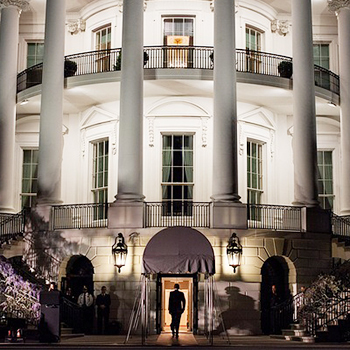 Want a quick and easy way to memorize the presidents of the United States?
Want a quick and easy way to memorize the presidents of the United States?
On this page, I’ll show you how.
Even better, I’ll show you an intermediate-level skill that will let you add their dates in office.
And if you want to go full-blown expert-level, you can add more details too. The more you explore memory techniques for powerful learning goals like committing American historical figures to your memory, the more you’ll be up to the demands of more rigorous memory tasks.
Excited? I sure am, so let’s get started!
How to Memorize the Presidents: An Ancient and Proven Method
First, you need to build a Memory Palace that is suited to the task.
A Memory Palace is a well-formed journey that you create in advance. Typically, it is based on a familiar building or route.
Some people prefer indoor journeys. Others like a mix of indoor and outdoor locations. And some people only use the outdoors. Yet others use fantasy locations like the homes in TV series or the landscapes of videos games.
How do you choose?
The answer is easy:
Start simply and keep in mind that you need quite a bit of space for all of the presidents. So let’s do the math as of 2020.
The current list involves 45 names.
That means your Memory Palace needs to have 45 different “loci.” That’s the Ancient Greek term used when talking about the Method of Loci. This has also been called the Roman Room method.
To make things more contemporary, I now call these “loci,” “Magnetic Stations.” You’ll see why when we get to the more advanced techniques. Once set up correctly, you can use them to literally stick more information in place, just like a magnetic can hold a calendar to the surface of a fridge – and allow you to slip in receipts, concert ticks and more.
Getting Started Tips:
To create 45 stations, I suggest you draw them on paper and make a journey that is linear and logical. It should not be something you have to memorize. It should be a journey that is already in your memory. That will save you time and energy.
For example, I will use this apartment and the surrounding neighborhood:
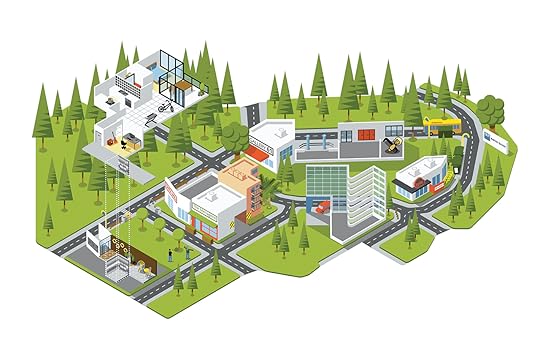
A Memory Palace Example for memorizing the presidents based on my local neighborhood
To identify 45 stations, I will start in the most logical spot that allows me to move slowly and in a linear journey. This is important because you want to move without confusing yourself as you proceed from one place to the next.
Numbering the stations is easy and might look like this:

Although this numbered Memory Palace won’t have all the presidents, it’s easy to “teleport” to a second one to finish the list.
Of course, you don’t need to hire a fancy artist to represent your Memory Palace for the presidents. You just need to get out a piece of paper and draw it. Like this:
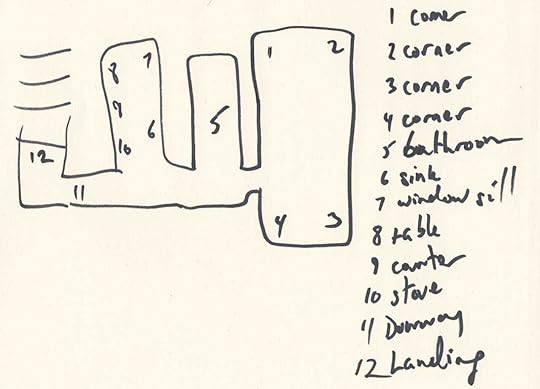
Start small. You don’t have to memorize all of the presidents in the same Memory Palace. You also don’t have to memorize all of them at once.
What you will need, however, is a strategy, and the Memory Palace technique is the best for reasons we’re about to explore.
A Proven 3-Step Process for Memorizing the Presidents with a Memory Palace
1. At this point, we’ve got the first step covered: Have one or more Memory Palaces prepared in advance.
This step is really important because you will slow yourself down if you create the Memory Palace as you go. This creates mental issues like worrying that you’ll run out of space or lead yourself into a dead end.
2. Step two is to begin with the first president and the first Magnetic Station of your Memory Palace.
You need to bring them both to mind at the same time. Let’s start small with the first four presidents and just one room of a Memory Palace. This one is made from an apartment I used to rent in Berlin, Germany:
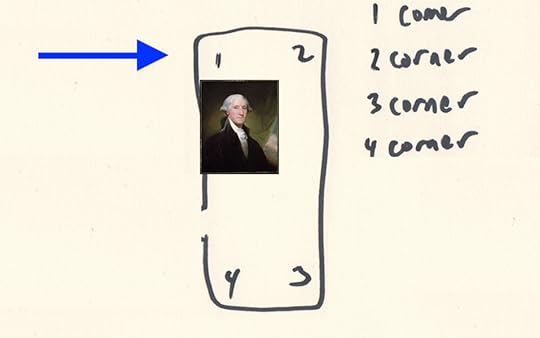
In your imagination, place the first president in the first corner of the Memory Palace you create. If you’re not visual, a quick sketch will help.
As I think about that first corner, I’m also going to think about George Washington.
Then, using a process called Elaborative Encoding, I’m going to allow my mind to bring up an association.
WARNING: There are some incredibly sophisticated techniques you can learn that help with the association process.
Some beginners go down the rabbit hole and try to learn these before they’ve mastered the fundamentals. Please don’t put the cart before the horse. Start simply and add tools like the pegword method to your skillset later.
For now, the easiest and most direct thing to do is think of another person named George. I think about George Duke, a musician who played with Frank Zappa.
I think about George Duke “washing” Frank Zappa’s hair on the first station of the Berlin apartment. This “encoding’ links the name George with the act of washing and that space in the Memory Palace, which makes it easier to “reverse engineer” later the name George Washington.
This process is like building a mathematical equation out of words, images, concepts and spaces in the world. The real trick is in making sure that it all makes sense to YOU personally.
For example, right now you might be scratching your head wondering who the heck George Duke and Frank Zappa are and how you’re going to find such rich imagery to use.
If that’s the case, the answer is simple: practice.
I used to be slow and rusty, just like everyone else who wants to memorize lists like the names of the presidents.
But with practice, I got much faster. And I put all that I know together for you in this simple course:
To continue, all you have to do is mentally move to the second station of your Memory Palace. As you’re thinking about that location, start to mentally “weave” together a new name with some imagery.
In this case, we’re looking at John Adams.
If you know these pop culture icons, you could have John Wayne in a shootout with a character from the Addams Family.
Or you could be a bit more abstract and think of the famous advertising writer David Ogilvy in a fight with John Hurt. John is a one-to-one name correspondence, but in the case of Ogilvy, your mind is making a leap between his name and the profession of advertising.
As you grow with these skills, you’ll discover many more ways to make associations. The more you learn about memory techniques and practice them, the faster your association skills will grow.
Now then, there’s one more step before we get to the advanced options like adding dates.
3. Step three is Active Recall. In order to get the information into long term memory, you really do have to “reverse engineer” the imagery you place in your Memory Palace.
As neuroscientist, memory athlete and memory expert Boris Konrad told us on this episode of the Magnetic Memory Method Podcast, no reliable memories can form without it.
Different people engage in Active Recall in different ways. Dominic O’Brien has suggested that you need to recall the information using his Rule of Five.
Personally, I’ve needed to be a bit more rigorous than that for much of the information I’ve memorized – but other times it can be less. It all depends on the nature of the information and your strategy.
For the presidents, I would suggest you work in small sets of 2-10 names. Keep a Memory Journal that includes your Memory Palace drawings. Then test yourself in writing about 5 times the first day – or more often. There is no magic number, which is why I created this video on the problem of learning to create your own “repetition rules.”
https://www.youtube.com/watch?v=8nOwZ...
The magic of memory techniques is that sometimes you’ll get the name back automatically without needing to think of the images you used.
Other times, you’ll get the images back first and then reverse engineer the name. Ultimately, you want to get the target information into your memory as quickly as possible. The better you get with the technique, the more you’ll develop a sense for how much repetition is needed.
Intermediate: The Best Way To Memorize The Presidents
Remember when I suggested not putting the cart ahead of the horse?
This suggestion still remains true. But the fact of the matter is that if you really want the best list of presidential info in your memory, you’re going to want to add the dates.
Here’s how:
You’ll need to learn a system that lets you memorize numbers rapidly. Things get a bit complicated because there are a few to choose from. My analysis of the Dominic System ultimately argues that the Major Method (sometimes called the Major System) is easier and better for most people, but it’s ultimately a personal preference.
The important factor is that you decide to be a person who improves your memory and make this a journey for life. You can add multiple techniques to your memory toolbox over time.
For the purposes of this tutorial, let’s assume you choose the Major. You just need to memorize this simple system:
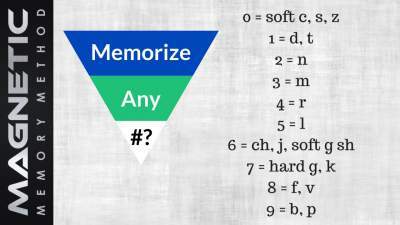
Then, when you see dates you want to memorize, you’ll combine the consonants to create words.
For example, Thomas Jefferson was the third president. I would think of a friend Thomas I know arguing with George Jefferson from the TV show, The Jeffersons. Then, using this system, I would make words for 1801-1809, which are his dates in office.
Since 18 is t+v in the Major, I’m actually already covered by my association for Thomas Jefferson. The Jeffersons is a TV show, after all. I just need to recognize that, link it to the Major and we’re good to go.

By adding another technique like the Major System, mental imagery will help you remember the dates each president spent in office.
But, if that’s too much of a leap for you in the beginning, you could imagine Jefferson on the third station of your Memory Palace smashing a TV (18) set down on the head of George Jefferson.
For 01, you could have a “sad” tragedy mask , which is the image I use for that number. Since zero can be represented by an S and one by a D, then “sad” is a perfect choice. The tragedy mask makes it more than a word by turning the concept of sadness into a tangible object.
(Pro tip: I go further than just using a non-specific mask. I think about the tragic mask worn by William Shatner in his performance of Oedipus Rex. This incredibly specific image based on a story I love makes the mnemonic imagery even more concrete to my imagination and thereby much easier to recall.)
For 1809, you can probably skip having the TV image twice. I used to use a Subaru driven by a friend of mine, but now have added memory expert Brad Zupp. If you’re following the formulas of the Major, you’ll note that both words work before:
Zero can be an S or Z and nine can be a B or P. S + B = Subaru or Z + P = Zupp.
(Pro tip: Many people will wonder about the additional letters in a word like Subaru and ask: Won’t that make you think you need to recall the number 094 because R can represent four? It’s a great question, but I’m sure that you’ll find in your own practice that your brain can sort it out. Memory techniques are filled with all kinds of little knacky things like this, so it’s really important not to overthink these things techniques. Once you have the fundamentals down, you’ll find that your brain is supple enough to manage what appears to be conflicts or contradictions.)
Now, what I’ve shared with you is a process of association that progresses toward having a number of images that combine a number of pieces of information. As you develop these images yourself, you can refine or change them. And you should, because the more you streamline them, the better your skills will grow.
In sum, imagine the third Magnetic Station of a Memory Palace. On it, your friend Thomas (or another Thomas you know) has a TV balanced on his left hand. It’s playing The Jeffersons and involves someone doing something crazy with a tragedy mask. On his right hand, memory expert Brad Zupp is stomping on a Subaru.
When you revisit this part of your Memory Palace later, you’ll be able to work it all out, ideally with pen and paper using your Memory Journal. You want this form of active recall in order to encourage the rapid flow of the information into long term memory.
Advanced: Adding More Information to the Presidents
At this point, I’m going to assume that you’ve gone through all of the presidents and at least have their names.
After that goal has been reached, the first round of additional information to add I’ve suggested is their dates in office. You could also explore adding a second round by adding their birthdates and dates of demise (where relevant).
But there are also interesting facts about them you can add. To accomplish that goal, here’s what I would suggest.
James Madison was the fourth president of the United States from 1809-1817. On my fourth Memory Palace station, I would see James Hetfield of Metallica getting mad at his son. To make it more concrete, his son would be the Seventh Son of a Seventh Son Iron Maiden sung about on the iconic album of that title. You could also use the actual sun in the sky, or the sun from the movie poster for Sunshine. The options are endless.
For the dates, making a new association for 1809 is not necessary in this case. You only need something for 17, in which case you could use a tack or someone like the political commentator Tucker Carlson. Or perhaps you could have a tack piercing Carlson (which I’m sure some people would like to do). Just that one additional image gives you the dates you need for this president.
Let’s say you wanted to also remember that Madison was Princeton University’s first graduate. You could add a prince’s crown to James Hetfield’s head. Or, you could tuck a copy of The Prince by Machiavelli under his arm (or have both images).
Let’s say you wanted to remember that Madison initially opposed the Bill of Rights. In this case, you could have him burning a document up, or scratching out what it says with a quill.
Use your imagination. The images you can add are endless. And if you run out of space, all you need to do is add a Memory Palace just for James Madison.
Common Questions About Memorizing The Presidents
How long will it take?
Some people manage to memorize all of them in under an hour. Others will need more time.
I suggest the following:
Instead of wondering how long it will take, have a strong reason why you’re memorizing the president. Then, if it takes a little longer, who cares? You’ll have fulfilled the reason and be able to soar past any bumps in the road.
How will I remember which president belongs to which number?
If you want to always remember that James K. Polk was the 11th president of the United States, you have a few options.
First, you can make all of your Memory Palaces the same. If each Memory Palace has 10 stations, for example, you can just do some simple math. Since Polk will be the first station in your second Memory Palace, he must be the eleventh president. This gives you an additional calculation to make, but it’s going to be great brain exercise for you.
Second, using the Major Method, you can develop an image for every digits from 00-99. This set of pre-designed images is fantastic and well worth developing – provided you develop the foundational skills first. Then, every station can automatically have an image that reminds you of its number without needing every Memory Palace to have a certain number of stations in order to provide a calculation.
Adding all of these additional images sounds messy! Won’t I get confused?
You might get confused if you haven’t developed the foundational skills. But in reality, most people who dedicate themselves to these techniques not only avoid confusion. They discover many wonderful options for scaling their skills over time. Typically, we find that all confusion is very welcome because it teaches us how to pivot our approach and improve over time.
Are there any songs I can use as an alternative?
Yes, and this is one of them:
https://www.youtube.com/watch?v=qDqCP...
However, learning this song does not diminish the need to learn a means of memorizing the song itself. If you prefer to go this route, here’s how to memorize a song.
Other people teach the Memory Palace differently? What makes this approach better?
It’s not a question of better or worse. It’s a question of the student’s willingness to focus on one teacher at a time. I recommend you have a strong why behind all of your learning projects. Then, when seeking memory improvement training, stick with one teacher at a time for at least a 90 day period. Do what they suggest and then add another teacher’s material, repeating the 90 day study principle.
Within a year, you’ll be a memory master and very grateful you focused on seriously learning these techniques instead of hopping all over the internet for the next “shiny new technique.” The reality is that all of the training out there is very similar, and your real goal is to become the kind of learner who studies and practices these techniques thoroughly.
After all, it’s (usually) only through serious study and practice in at least one profession that anyone gets to be president in the first place, right?
June 4, 2020
John Michael Greer On Giordano Bruno, Memory and Time
 Few authors have provided as many lenses through we can see and interpret science, language and memory as John Michael Greer.
Few authors have provided as many lenses through we can see and interpret science, language and memory as John Michael Greer.
As an author, Greer is known for his work with the ideas of Giordano Bruno and, most recently, his translation of On the Shadows of the Ideas.
Greer has also authored many books on the subjects of spirituality and the occult, economics and political change. He’s also published fiction and served as a druid and initiate in Freemasonry and the Hermetic Order of the Golden Dawn.
On this episode of the Magnetic Memory Method Podcast, we focus on Bruno’s memory systems and the nature of knowledge from what he calls “the rubbish heap of history.”
Is that what Bruno’s texts and the Picatrix amount to? Press play now to see if you agree as we discuss:
The importance of “intellectual dumpster diving” to real learning and preservation of ideas
Why more than a literal translation can be self-serving, but somehow it can’t be avoided
The reason photocopies (of photocopies) are an accurate parallel of our relationship to ancient philosophy
Why Bruno is the zenith of the Renaissance art of memory
The reason subject/abject memorization is the most sophisticated method to memorize text
A mystery of modern times – the widespread avoidance of using the alphabet as a memory tool…
And why overwhelm can occur, even with this simple sequence
Why, in Bruno’s time, knowledge and secrecy went hand-in-hand
The reason Frances Yates’ ideas about Bruno should be viewed with discernment
The delusion of treating history as a straight line, and why this idea is wildly inaccurate, given the way the universe operates
[image error]
Giordano Bruno
Did Giordano Bruno Write The Ultimate Memory Improvement Book?
That’s probably a silly question. After all, aren’t the Memory Palace books you put into action the “best”?
Nonetheless, I was really excited when Greer’s new translation of De Umbris Idearum appears on the scene, which is why I held this special livestream:
https://www.youtube.com/watch?v=qcDgp...
I highly recommend everyone serious about memory techniques not only read this book, but endeavor to understand it by taking action based on its suggestions.
Spend at least 90 days in practice. Embrace the challenge, as suggested by John Graham.
Then, and only then, add another memory training book. You’ll be glad you did based on solid understanding, rather than flighty “shiny new memory book” behaviors.
Because if you don’t take action on the books you read, then Greer is right: they’ll be found on the trash heap of all the other books you’re not milking for the value they contain.
Further Resources on the web, this podcast, and the MMM Blog:
John Michael Greer’s Ecosophia Blog (Toward an Ecological Spirituality)
John Michael Greer’s Amazon author page
John Michael Greer Presents: Masonry and the Secret Societies
Frances Yates’s Giordano Bruno and the Hermetic Tradition
The Illustrated Picatrix: The Complete Occult Classic of Astrological Magic
Scott Gosnell Talks About Giordano Bruno
June 3, 2020
13 Powerful Cognitive Activities For Adults To Sharpen Your Brain
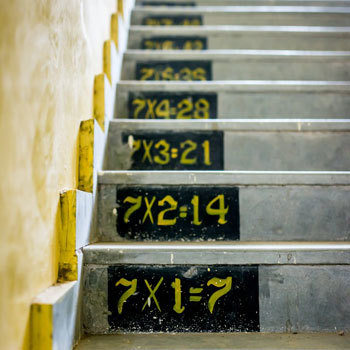 Are you looking for cognitive activities for adults to stimulate your brain?
Are you looking for cognitive activities for adults to stimulate your brain?
Your cognitive abilities and brain health may weaken with age, illness, or poor habits.
Cognitive stimulation activities are a great way to defy this deterioration — helping you improve your attention, memory, and overall mental health.
In this article, we’ll take a brief look at cognitive processes. I’ll also show you 13 stimulating activities for cognitive development that will keep your brain fighting-fit, even as you age.
Here’s What I’ll Cover In This Post:
What Are Cognitive Processes?
13 Activities For Strengthening Cognitive Processes For Adults
Why are Cognitive Processes Important?
Do Cognitive Processes Decline as You Age?
What Are Cognitive Processes?
While you were binge-watching The Mandalorian, a burning smell caught your senses.
You dashed to the kitchen to turn off the oven.
As you cleaned up the mess, your brain made a list of ingredients you need to bake that cake again.
You then drove to the grocery store, bought the ingredients, and returned home to bake again.
What a day!
But it was worth every bite of that oozy, chocolatey delight sitting at your kitchen counter.
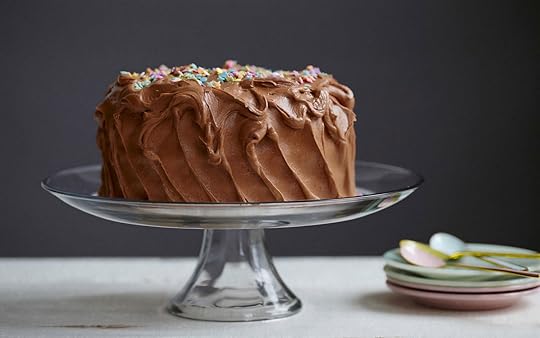
Now:
Did you realize you used many of your cognitive skills in the above scenario?
In his 1967 book, Ulric Neisser defined cognition as “how sensory inputs are transformed, reduced, elaborated, stored, recovered, and used.”
What are the Different Cognitive Processes?
Here’s a closer look at the various cognitive skills you use in your daily life. They include attention, memory, logic, reasoning, and visual and auditory processing.
They help you process the world around you.
Attention
Attention allows you to concentrate on a particular activity or stimulus instead of processing everything around you.
Activities such as walking, wearing clothes, and driving require little attention because the repeated practice has made them a part of your routine. But activities like responding to a friend in crisis would require more attention.
Your attention could also be selective to a strong stimulus, letting you focus only on it. For example, you could listen to a podcast on the radio amid noisy traffic or work on your laptop with the TV switched on.

Sensation and Perception
Sensation is the process of receiving information from the environment through your sensory organs — eyes, ears, nose, tongue, and skin.
Perception is the process by which you interpret this information. Past experiences influence your perception and allow you to make sense of the world around you.
Gestalt psychologists believe that we perceive our reality as a whole rather than the sum of different parts. For example, a dotted line (…………….) will be seen as a line and not as separate dots.
Comprehension
To comprehend means to understand and interpret what you read or hear. Your brain decodes the language of what you’ve read and makes connections with what you already know.
For example, you read, “The train left the station and John’s friend was gone forever.” To process this sentence, you need to understand what is left unsaid: John’s friend was on that train.

Memory
Memory is made up of three processes: acquiring, storing, and retrieving information on ideas, facts, images, habits, or events around you. It is the store of all things you’ve learned and retained from your activities and experiences.
Cognitive reserve is the brain’s ability to find alternate ways of getting things done. You can only improve it by performing new tasks and challenging the brain to learn new skills.
That is where cognitive activities for adults can come to your rescue. Some of them even help people with Alzheimer’s and dementia.
13 Powerful Cognitive Activities for Adults
You’ll find plenty of cognitive stimulation activities for adults, including exercise workbooks and several enticing online brain training games and apps.
I’d suggest you stay away from online apps as they may make you good at completing those tasks, but don’t really stimulate your brain.
Here are my top recommendations for cognitively stimulating activities, especially for older people. All of these will improve your cognitive skills — attention, comprehension, perception, memory, reasoning, and/or processing speed.
1. Mindful Walking
A recent study on mindfulness established that mindfulness-based exercises help elders with mild cognitive impairment improve their daily life.
When you step out for a morning walk, concentrate on sensations like the wind in your hair, your breathing, or the sounds around you.
While the walk keeps you physically active, this mindfulness will help you build your attention span, filter out distractions, and boost your overall cognitive health.

2. Drawing
Drawing or illustration involves the use of cognitive abilities such as perception and memory. A study also suggests that the process of drawing can help older adults fight memory loss.
Observe a complex drawing with multiple colors or layers, and try to replicate it later. Or take in a scene around you and draw it on paper, bringing out all the minute details.
3. Counting Letters
Select a paragraph from any book and count the number of times a particular letter appears. This will help you sustain your attention by focusing on one letter for an extended period of time.
In a study on older people, researchers have used this cognitive stimulation activity to measure everyday attention.
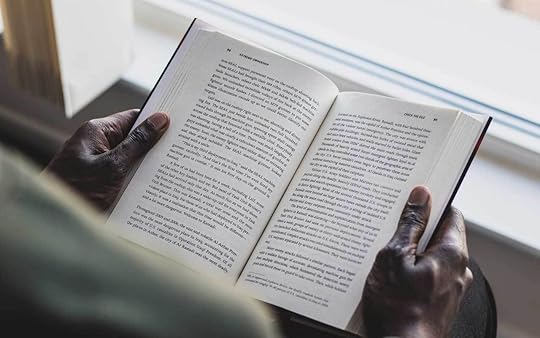
4. Color Arrangement
Take a piece of printed cloth and find out how many shades of a particular color are present in it.
Color has cognitive stimulation properties and helps older folks improve their spatial memory.
5. Approximation and Estimation Exercises
Keep two spoons next to each other on a desk. Then move the second spoon away from the first spoon. Now figure out how many spoons you can fit in between them.
This is a handy exercise that adults can do easily to improve perception and information processing abilities.

6. Card Games
Poker, Solitaire, and other card games for seniors can improve cognitive function — especially logical problem solving and memory retention.
Try this card-matching game:
Pick 8 to 12 pairs of identical cards and lay them face down on the desk. Ensure that the pairs are not together. Pick any two cards at a time and see if they match. See how many pairs you can match in five minutes.
Keep increasing the number of pairs, to improve your memory and attention span gradually.
7. Word Games
Try out crossword puzzles, Scrabble, or any other word game that you enjoy.
Here’s another one — finding unrelated words. Pick a random word and think of words that are not related to it. If you pick ‘sky,’ then words like the moon, sun, night, or birds are not allowed.
This exercise will help you improve your comprehension skills. Elderly adults can play this engaging brain game with their family members or caretakers.

8. Remembering Sequences
Try to remember words in a particular order. For example, list all the fruits you know. After an hour or so, try to remember the fruits in the same order.
This is a classic memory improvement technique. You could do multiple variations such as unknown words, nonsense words, and increased distractions.
9. Number Games
Calculation exercises and number games like Sudoku will keep your problem-solving skills sharp.
Here’s an interesting twist — a license plate game. When you see license plates on vehicles, you could try to figure out the relationship between those numbers. For example, XX4812 could be 4 + 4 = 8 and 8 + 4 = 12. Alternatively, 12 * 4 = 48, hence, 4812.
This is an entertaining game that elderly adults can even play from the comfort of their home balconies to improve their memory and processing speed.

10. Board Games
Board games like chess can help you boost your IQ, concentration, and focus.
Get some partners to play with and alternate among Checkers, Clue, Monopoly, or any other board game to increase your creativity and cognitive functioning.
11. Reading
Researchers have proven the power of reading in keeping Alzheimer’s disease at bay. Besides keeping you informed and entertained, it will spark your imagination and exercise your brain.
You could read magazines, fiction, or non-fiction books. To make it more effective, retell the gist of what you read to someone.

12. Physical Exercise
A study by Italian researchers proved that regular physical activity “is a strong gene modulator that induces structural and functional changes in the brain”, leading to improved cognitive skills and wellbeing.
The Alzheimer’s Association says that regular exercise may be a beneficial strategy to lower the risk of Alzheimer’s disease and vascular dementia as well.
Choose a workout routine that you enjoy and stick to it — be it aerobic exercise, resistance training, badminton, or swimming.
13. Creating Memory Palaces
Creating Memory Palaces using the Magnetic Memory Method is an incredible memory technique that boosts your long term memory.
To make it simpler on your brain, always draw them out before using them in your mind.

Then, when learning a new language, mentally walk around your home. Use associations to place vocabulary and phrases related to shopping (in that language) on your kitchen counter, or the words related to travel on your sofa.
This will help you store the information in your long-term memory and recall it easily at will. You can also try mind mapping to activate yet another level of your memory and creativity when learning something new.
Why are Cognitive Processes Important?
Cognitive processes let you:
1. Understand sensory inputs:
Your brain transforms the sensations and information around you into signals for you to understand and act on.
That’s how you instinctively drop a hot piece of coal or turn when someone calls your name, or push a person onto the sidewalk when you see a vehicle dangerously veering towards them.
2. Elaborate information:
When you recall information, sometimes your brain fills in the missing pieces.
For instance, while buying groceries, you may remember an item that needs to be restocked but wasn’t on your list. Also, at times when you narrate incidents to your friends, you may add details that weren’t part of the original memory.

3. Remember and recall information:
Your short-term memory stores information, such as the office address for your upcoming interview. And your long-term memory helps you remember your childhood home address or a language you learned at age five.
4. Contextualize information and solve problems:
Cognitive processes link past information to current information and help you make decisions to solve problems. Your attention to your surroundings, memories, understanding of language, biases, and judgments all contribute to how you interact with your environment.
For example, you rush to turn off the oven when there’s a slight burning smell because you know the consequences of what might follow if you don’t.
Now, here’s another important question:
Do Cognitive Processes Decline as You Age?
The answer is – yes – just as much as your physical function weakens with age.
Some cognitive skills start to fade with age, especially your memory and attention.

How does cognitive decline manifest itself?
Here’s how:
Life experiences that come with age (like your knowledge or vocabulary) remain stable. But your abilities such as riding a bicycle start to decline.
Your childhood memories remain relatively intact, but forming new ones gets difficult. It may get tougher to remember where you kept the house key or spectacles, or the name of the new neighbor you met yesterday.
Older adults may show a slower reaction time (the speed at which we respond to stimuli).
Paying attention to multiple activities such as watching TV while chopping vegetables might become difficult.
Solving problems and puzzles will take more time than when you were younger.
Progressive neural decay leads to neurodegenerative conditions such as Parkinson’s disease, dementia, and Alzheimer’s disease.
People with Mild Cognitive Impairment (MCI) are considered to be at an increased risk of Alzheimer’s disease or dementia. In their study, researchers Roberts and Knopman proved that 15% to 20% of people aged 65 or older have MCI.
Diseases like Alzheimer’s and dementia are incurable, and a healthy cognitive reserve is the only way to combat these diseases. Some people who are diagnosed with mild-to-moderate dementia or Alzheimer’s disease opt for psychological intervention, including Cognitive Stimulation Therapy.
Cognitive Stimulation = Get a Super-Fit Brain
Keeping your cognitive processes sharp is a critical part of successful aging.
All these brain-stimulating activities, especially the powerful Memory Palace technique, will help you improve your cognitive performance effectively — even as you go about your day-to-day life and social activities.
If you want to learn more about how to improve your memory (including how to use a Memory Palace), sign up for your free memory improvement kit.




